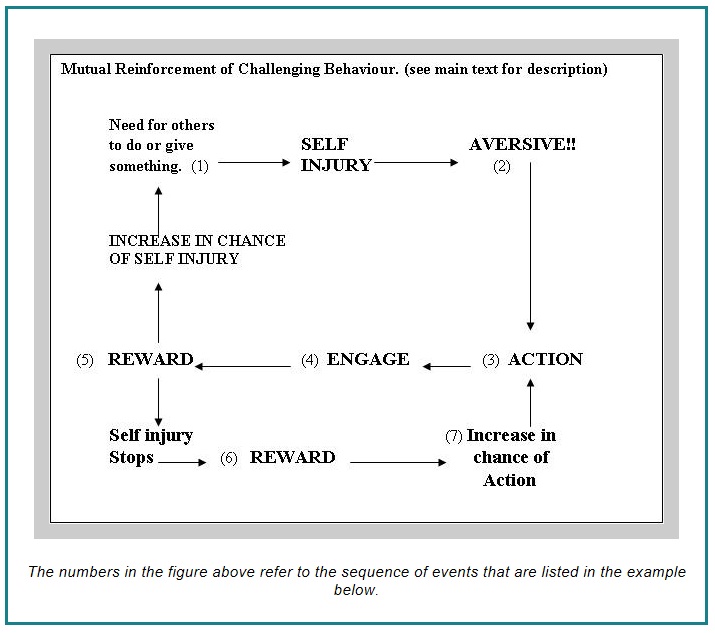Understanding the Mutual Reinforcement Process
A person may be inadvertently rewarded for showing behaviours that challenge. Sometimes the other person in the interaction also has their behaviour rewarded. This is the process of mutual reinforcement.
If we consider this process within the positive reinforcement example regarding attention-maintained behaviour, then we can see that not only is the other person rewarding the child but the child is also rewarding the other person. This process is shown in the figure below:

- The child is on their own and has no stimulation. Initially, the child may show self-injurious behaviour for various reasons. These include: it gives rise to pleasant sensory stimulation, it relieves discomfort, as the end result of a stereotyped behaviour, or it may be simply a chance act.
- The self-injury occurs and is seen by another person (parent or carer).
- The other person finds the self-injury unpleasant or aversive and consequently acts to stop the self-injury from recurring, or tries to understand the reason for the self-injury.
- The other person engages with the child who has just shown self-injurious behaviour and whilst preventing further instances of self-injury and trying to find the cause may comfort, distract or restrain the person.
- As the child has now received a reward (the interaction) there is no longer any motivation for the self-injury to continue and the self-injurious behaviour stops.
- As the self-injurious behaviour has now stopped the other person has been rewarded by the removal of the unpleasant event (the self-injurious behaviour). This reward is the feeling of relief that happens when a child stops self-injuring, even for a short period of time.
- As the response by the other person to the self-injury is rewarded it makes it more likely that the person will make the same response to the self-injurious behaviour in the future and so reward the person again.
It is worth thinking about some other things that are always occurring in this process
What happens if the other person does not make a rewarding response to the behaviours that challenge?
Under these circumstances the child will still have a need for the reward (i.e., is motivated, see step 1 in the figure above) and so the behaviours that challenge will continue. As the behaviours that challenge continue the other person will present more things until they eventually hit on the right thing and then the child will stop the self-injury. In this way the person is inadvertently taught by the child precisely how to reward the behaviours that challenge.
This sequence of events shows that just as the other person is inadvertently rewarding the child for showing behaviours that challenge, the child is inadvertently rewarding the other person for rewarding the behaviour. This does not mean that the child intends to control the behaviour of the other person, it is simply the consequence of the natural sequence of events that occurs around any bout of socially reinforced behaviours that challenge.



